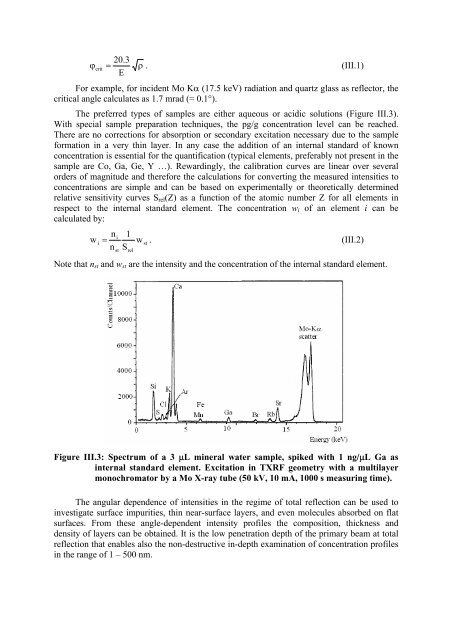X-Ray Fluorescence Analytical Techniques - CNSTN : Centre ...
X-Ray Fluorescence Analytical Techniques - CNSTN : Centre ...
X-Ray Fluorescence Analytical Techniques - CNSTN : Centre ...
You also want an ePaper? Increase the reach of your titles
YUMPU automatically turns print PDFs into web optimized ePapers that Google loves.
20.<br />
3<br />
ϕcrit<br />
= ρ . (III.1)<br />
E<br />
For example, for incident Mo Kα (17.5 keV) radiation and quartz glass as reflector, the<br />
critical angle calculates as 1.7 mrad (= 0.1°).<br />
The preferred types of samples are either aqueous or acidic solutions (Figure III.3).<br />
With special sample preparation techniques, the pg/g concentration level can be reached.<br />
There are no corrections for absorption or secondary excitation necessary due to the sample<br />
formation in a very thin layer. In any case the addition of an internal standard of known<br />
concentration is essential for the quantification (typical elements, preferably not present in the<br />
sample are Co, Ga, Ge, Y …). Rewardingly, the calibration curves are linear over several<br />
orders of magnitude and therefore the calculations for converting the measured intensities to<br />
concentrations are simple and can be based on experimentally or theoretically determined<br />
relative sensitivity curves Srel(Z) as a function of the atomic number Z for all elements in<br />
respect to the internal standard element. The concentration wi of an element i can be<br />
calculated by:<br />
n 1<br />
w = w . (III.2)<br />
i<br />
i<br />
n st Srel<br />
st<br />
Note that nst and wst are the intensity and the concentration of the internal standard element.<br />
Figure III.3: Spectrum of a 3 µL mineral water sample, spiked with 1 ng/µL Ga as<br />
internal standard element. Excitation in TXRF geometry with a multilayer<br />
monochromator by a Mo X-ray tube (50 kV, 10 mA, 1000 s measuring time).<br />
The angular dependence of intensities in the regime of total reflection can be used to<br />
investigate surface impurities, thin near-surface layers, and even molecules absorbed on flat<br />
surfaces. From these angle-dependent intensity profiles the composition, thickness and<br />
density of layers can be obtained. It is the low penetration depth of the primary beam at total<br />
reflection that enables also the non-destructive in-depth examination of concentration profiles<br />
in the range of 1 – 500 nm.


